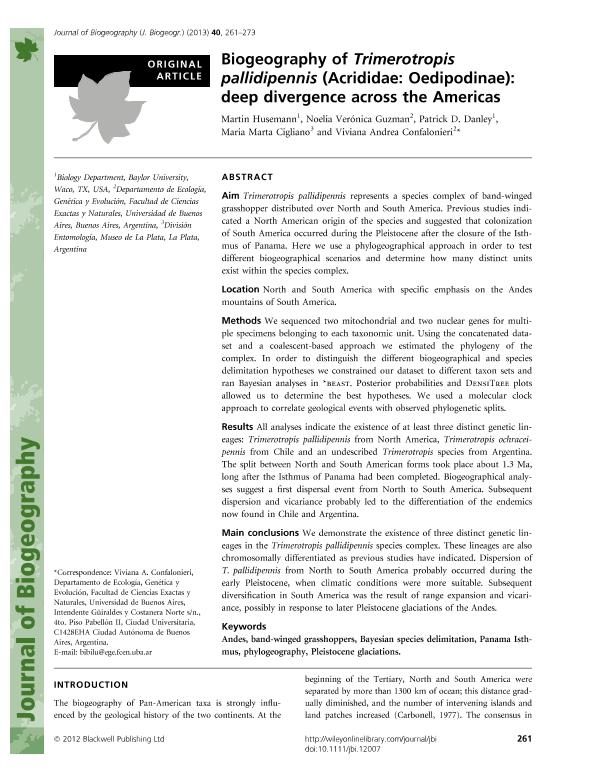Artículo
Biogeography of Trimerotropis pallidipennis (Acrididae: Oedipodinae): deep divergence across the Americas
Husemann, Martín; Guzman, Noelia Veronica ; Danley, Patrick D.; Cigliano, Maria Marta
; Danley, Patrick D.; Cigliano, Maria Marta ; Confalonieri, Viviana Andrea
; Confalonieri, Viviana Andrea
 ; Danley, Patrick D.; Cigliano, Maria Marta
; Danley, Patrick D.; Cigliano, Maria Marta ; Confalonieri, Viviana Andrea
; Confalonieri, Viviana Andrea
Fecha de publicación:
04/2013
Editorial:
Wiley
Revista:
Journal Of Biogeography
ISSN:
0305-0270
Idioma:
Inglés
Tipo de recurso:
Artículo publicado
Clasificación temática:
Resumen
Aim Trimerotropis pallidipennis is a species complex of band-winged grasshopper distributed over North and South America. Previous studies indicated a North American origin of the species and suggested that colonization of South America occurred during the Pleistocene after the closure of the Isthmus of Panama. Here we use a phylogeographical approach in order to test different biogeographical scenarios and determine how many distinct units exist within the species complex. Location North and South America with specific emphasis on the Andes mountains of South America. Methods We sequenced two mitochondrial and two nuclear genes for multiple specimens belonging to each taxonomical unit. Using the concatenated dataset and a coalescent-based approach we estimated the phylogeny of the complex. In order to distinguish the different biogeographical and species delimitation hypotheses we constrained our dataset to different taxon sets and ran Bayesian analyses in *beast. Posterior probabilities and DensiTree plots allowed us to determine the best hypotheses. We used a molecular clock approach to correlate geological events with observed phylogenetic splits. Results All analyses indicate the existence of at least three distinct genetic lineages: Trimerotropis pallidipennis from North America, Trimerotropis ochracei- pennis from Chile and an undescribed Trimerotropis species from Argentina. The split between North and South American forms took place about 1.3 Ma, long after the Isthmus of Panama had been completed. Biogeographical analyses suggest a first dispersal event from North to South America. Subsequent dispersion and vicariance probably led to the differentiation of the endemics now found in Chile and Argentina. Main conclusions We demonstrate the existence of three distinct genetic lineages in the Trimerotropis pallidipennis species complex. These lineages are also chromosomally differentiated as previous studies have indicated. Dispersion of T. pallidipennis from North to South America probably occurred during the early Pleistocene, when climatic conditions were more suitable. Subsequent diversification in South America was the result of range expansion and vicariance, possibly in response to later Pleistocene glaciations of the Andes.
Palabras clave:
Andes
,
Grasshopper
,
Bayesian Species Delimitation
,
Panama Iisthmus
Archivos asociados
Licencia
Identificadores
Colecciones
Articulos(CEPAVE)
Articulos de CENTRO DE EST.PARASITOL.Y DE VECTORES (I)
Articulos de CENTRO DE EST.PARASITOL.Y DE VECTORES (I)
Articulos(IEGEBA)
Articulos de INSTITUTO DE ECOLOGIA, GENETICA Y EVOLUCION DE BS. AS
Articulos de INSTITUTO DE ECOLOGIA, GENETICA Y EVOLUCION DE BS. AS
Citación
Husemann, Martín; Guzman, Noelia Veronica; Danley, Patrick D.; Cigliano, Maria Marta; Confalonieri, Viviana Andrea; Biogeography of Trimerotropis pallidipennis (Acrididae: Oedipodinae): deep divergence across the Americas; Wiley; Journal Of Biogeography; 40; 2; 4-2013; 261-273
Compartir



